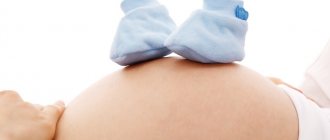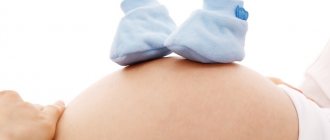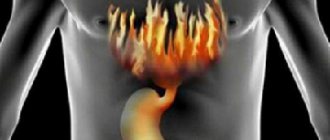OBSTETRIC FORCEPS
(
forceps obstetricia
) - 1) an operation of artificial extraction of a live full-term or almost full-term fetus by the head (rarely by the buttocks) in case of urgent need to complete the second stage of labor using a special instrument - obstetric forceps; 2) obstetric instrument. The design of obstetric forceps and their various models - see Obstetric and gynecological instruments.
The first description of obstetric forceps was made in the second edition of Heister's manual of surgery (L. Heister, 1683-1758), published in Holmstedt in 1724. (see Obstetrics). The purpose of obstetric forceps is to replace the expelling force of the uterus and abdominal muscles of the woman in labor with the attracting force of the doctor. Obstetric forceps are only a retraction instrument, not a rotational or compression instrument. The known compression of the head, inevitable when applying obstetric forceps, should be minimal.
More or less compression of the head depends on whether the obstetric forceps are applied correctly and whether the direction of the drive corresponds to the mechanism of fetal birth. Excessive compression of the head with obstetric forceps is dangerous for the life of the fetus (fractures of the skull bones, hemorrhage in the brain).
Indications, conditions and contraindications for the operation of applying obstetric forceps. The application of obstetric forceps is indicated in all cases where the mother, the fetus, or both are in danger during the expulsion period, which can be eliminated by immediate removal of the fetus. Indications may include: insufficiency of labor (in case of secondary weakness of labor forces, obstetric forceps should be applied if the expulsion period for primiparous women lasts more than 2 hours, and for multiparous women - more than one hour); severe nephropathy and eclampsia that cannot be eliminated by appropriate conservative treatment; premature placental abruption; diseases of the mother without stable compensation or remission (endocarditis, heart defects, hypertension, nephritis, pneumonia, tuberculosis and others); febrile state of a woman in labor with high temperature, fetal hypoxia. Certain conditions are required to apply obstetric forceps. The dimensions of the pelvis must be sufficient for the passage of the head removed with forceps. Forceps can only be applied when the external pharynx of the cervix is fully dilated (the insertion of spoons and especially the removal of the head when the pharynx is not fully dilated inevitably leads to rupture of the cervix and lower segment of the uterus).
Before applying obstetric forceps, the obstetrician must clearly understand in which part of the pelvis (cavity or outlet) the fetal head is located and what its position is. The forceps can be applied to the fetal head, standing as a large segment in the cavity (the wide and narrow part of it) or at the pelvic outlet. If the fetal head has descended into the cavity or to the pelvic floor, this is convincing evidence that there is no discrepancy between the sizes of the pelvis and the fetus, except in very rare cases of a funnel pelvis (it is important to measure the planes of pelvic outlet!). Forceps should, as a rule, only be used for cephalic presentations. The head should not be too large (hydrocephalus) or too small (forceps should not be applied to the head of a fetus less than 7 months old), it should have normal density (otherwise the forceps will slip off the head during attraction). The amniotic sac must be ruptured and the membranes tucked behind the largest circumference of the head: the forceps do not hold well on the membranes, and if they do, the attraction to the membrane will cause premature abruption of the placenta. The fetus must be alive. If the fetus is dead, then the operation of craniotomy rather than forceps is less traumatic for the mother. Obstetric forceps should not be used if there is a threatening or existing uterine rupture, as well as with a posterior view of the facial presentation (chin posterior).
Preparation for the operation of applying obstetric forceps and pain relief
Before applying obstetric forceps, it is necessary to carry out an internal examination and accurately determine the location of the head, the wire point of the head, navigate the position of the sagittal suture, the degree of opening of the external pharynx of the cervix, etc. When applying obstetric forceps, it is desirable to use inhalation anesthesia (see). When exiting obstetric forceps, you can limit yourself to bilateral anesthesia of the pudendal nerves or intravenous administration of epontol. Obstetric forceps are applied with the woman in labor on her back; she should be laid on the operating table or Rakhmanov bed with her legs brought to her stomach, held by assistants; in the absence of the latter, leg holders are used. The bladder is emptied using an elastic catheter. For this purpose, when the presenting part is located low, 2-3 fingers of the right hand are inserted into the vagina between the symphysis and the head, with the back surface to the pubis, the fingers are slightly spread apart and they try to carefully insert a catheter into the urethra. A metal catheter should not be inserted, as this may damage the urethra. The external genitalia, upper part of the inner thighs and tissue in the perineal area are thoroughly disinfected.
General principles of applying obstetric forceps with pelvic curvature (the most commonly used is the Fenomenov-Simpson model). When applying forceps, first of all, it is necessary to clearly and accurately know the mechanism of fetal birth and remember three basic rules: 1) the forceps must capture the largest surface of the head, the tops of the spoons of the forceps must extend beyond the parietal tubercles; Failure to comply with this rule may result in the spoons of the tongs slipping; 2) the forceps should be applied so that the tops of their spoons are directed towards the wire point, and the concavity of the pelvic curvature of the instrument is facing the pubis; 3) the tongs must be locked in such a way that the wire point is always in the plane of the head curvature of the instrument, that is, by placing the locking parts of the tongs in the same plane, their handles should be connected so that the spoons grip the proper surface of the head.
Depending on the height of the head, the forceps can be closed: a) directly on the obstetrician (horizontally); b) with the handles raised anteriorly (upwards); c) with the handles lowered backwards. Obstetric forceps can be applied typically and atypically. Typical A. shch. applied to the fetal head, which has completely completed the internal rotation (rotation), to its transverse (biparietal) size and in the transverse size of the pelvis. Such obstetric forceps are also called output forceps, since the head is located at the outlet of the pelvis. With typical obstetric forceps, the head is grasped in the temporoparietal region. With this grip, the above three rules for applying forceps are observed. Obstetric forceps, which have to be applied to the head, which has not yet completed rotation, located in the pelvic cavity (in its narrow or wide part), are called atypical, or cavitary. Atypical obstetric forceps have to be applied: 1) to the head, which has not completely completed the internal rotation (the sagittal suture is located in one of the oblique dimensions of the pelvis); 2) with a low transverse position of the head. When applying atypical obstetric forceps, one general rule should be followed: they must be applied in the oblique size of the pelvis, opposite the sagittal suture or facial line. If the sagittal suture is located in the left oblique dimension, then the spoons of the forceps are located in the right oblique dimension and vice versa. In both cases, the forceps grasp the head in the ear area (perfect capture). When the transverse position of the head is low, obstetric forceps with pelvic curvature are applied according to the general rule: in one of the oblique dimensions where the wire point is deviated - the small (posterior) fontanel. The forceps grasp the parietal tubercle and temporal region. This capture of the head is not perfect, but it manages to meet the requirement that the pelvic curvature of the forceps and the birth canal almost coincide. High forceps are atypical when they grasp and try to remove the fetal head located above or at the entrance to the pelvic cavity. Currently, high obstetric forceps are not used, since this operation is very difficult and traumatic for the mother and fetus. In cases where it is necessary to quickly complete childbirth with this position of the head, they resort to cesarean section (see) or vacuum extraction (see) of the fetus.
Obstetric forceps: how they are used
Forceps is an instrumental aid in vaginal birth used when labor is progressing slowly and there is a high risk of fetal death and serious complications for the laboring woman. Obstetric forceps (they come in several varieties) are sterile medical instruments that resemble salad forceps made from medical grade stainless steel. Its branches grip the baby's head and, by pulling, promote a smooth exit from the birth canal.
Important
Doctors choose this method of delivery extremely rarely, when the baby needs to be removed from the uterus quickly, and there are simply no other, safer options.
Technique for applying obstetric forceps with pelvic curvature
Technique for applying obstetric forceps with pelvic curvature
(general rules).
The technique of applying both typical and atypical obstetric forceps includes the following five points: 1) insertion of spoons; 2) closing the forceps; 3) test traction; 4) traction itself (pulling the head with forceps); 5) removing the forceps. A positive result of the operation can only be guaranteed if the purpose, purpose and technique of each of these points is carefully studied. Rice.
1. Folded forceps The first moment of the operation.
The left spoon is introduced first.
When closing the tongs, it must lie under the right one, otherwise closing the tongs will be difficult, since a significant part of the lock (pin, pin, plate) is always on the left spoon. In order not to make a mistake when choosing a spoon, you should make it a rule to fold the forceps before insertion (Fig. 1) in order to clearly see which of the spoons is the left and which is the right. Then the obstetrician spreads the genital slit with his left hand and inserts four fingers of his right hand into the vagina along its left wall. Rice.
2. Insertion of the left spoon when applying exit forceps Fig. 3. Insertion of the right spoon when applying exit forceps If the edges of the external os of the cervix are still preserved, then it is necessary to determine the gap between its edges and the head. Next, with the left hand, take (like a writing pen or like a bow) the left branch of the forceps by the handle and lift the handle anteriorly and to the right inguinal fold of the woman in labor so that the top of the spoon of the forceps enters the genital slit according to its longitudinal (antero-posterior) diameter. The lower edge of the spoon rests on the thumb of the right hand. The spoon is inserted into the genital slit, pushing its lower rib with the thumb of the right hand and under the control of the fingers inserted into the vagina (Fig. 2). The spoon should slide between your index and middle fingers. When inserted correctly, the spoon should lie so that the head curvature of the forceps does not capture the edge of the pharynx and fits well to the head; the insertion of the obstetrician's right hand is intended to control the advancement of the spoon. As the spoon moves into the birth canal, the handle of the forceps should approach the midline and descend posteriorly. The spoon must be inserted with great care, easily, smoothly, without any violence. The correct position of the spoon in the pelvis can be judged by the fact that the Bush hook is positioned strictly in the transverse dimension of the pelvic outlet (in the horizontal plane). The inserted left spoon must certainly go beyond the ends of the fingers, therefore, beyond the parietal tubercle, located in the temporo-parietal region of the head. If the spoon is inserted deep enough, the lock is close to the external genitalia. When the left spoon fits well on the head, its handle is handed over to the assistant. The right (second) spoon of the forceps is inserted in the same way as the left one (Fig. 3), with the right hand to the right side under the protection of the fingers of the left hand inserted into the vagina.
Rice. 4. Closing the lock when applying the exit forceps Fig. 5. Correctly applied exit forceps for anterior view of occipital presentation: the small fontanelle (wire point) is in the plane of the forceps
The second moment of the operation.
To close the pliers, each handle is grasped with the same hand so that the thumbs are located on the Bush hooks.
After this, the handles are brought together and the forceps are easily closed (Fig. 4). Properly applied obstetric forceps tightly grasp the head along its large oblique size (in the direction from the back of the head through the ears to the chin) - biparietally. The sagittal suture occupies a mid-position between the spoons, the curved tops of which are directed anteriorly, the leading point of the head (posterior fontanel) is in the plane of the forceps (Fig. 5). The inner surfaces of the handles of the pliers should be close to each other (or almost close). A sterile napkin folded 2-4 times is placed between the handles; This ensures good alignment of the spoons of the forceps to the head and avoids the possibility of excessive compression in the forceps. Having closed the forceps, you should carefully examine whether they have captured the soft tissue of the birth canal. Rice.
6. Test traction when applying exit forceps. Anterior view of occipital presentation The third moment of the operation.
Test traction allows you to once again verify the correct application of the forceps (whether the head follows the forceps).
To do this, the obstetrician grabs the handles of the forceps with his right hand from above so that the index and middle fingers lie on the Bush hooks. At the same time, he places his left hand on the back surface of his right, with the end of the extended index or middle finger touching the head (Fig. 6). If the forceps are applied correctly, then during the attraction process the fingertip will always be in contact with the head. Otherwise, it slowly moves away from the head, the distance between the lock of the tongs and the head increases, and their handles diverge: the tongs begin to slip and they must be immediately repositioned. Rice.
7. Grasping the handles of the forceps during traction Fig. 8. Grasping the handle of the forceps according to Tsovyanov. The fourth moment of the operation.
After making sure that the forceps are applied correctly, they begin to extract the fetus with forceps (traction itself). To do this, the index and ring fingers of the right hand are placed on the Bush hooks, the middle finger is placed between the diverging branches of the forceps, and the thumb and little finger cover the handles on the sides. The left hand clasps the handles from below (Fig. 7). The main traction force is developed by the right hand. When extracting a fetus using obstetric forceps, it is necessary to carry out all manipulations in accordance with the mechanism of its birth in each individual case and take into account three points: the direction of traction, the strength, and the nature of the traction. According to the direction, traction is divided posteriorly (with a horizontal position of the woman in labor - from top to bottom), towards itself (parallel to the horizon) and anteriorly (from bottom to top). These directions are determined by the desire to imitate the natural mechanism of birth and advancement of the fetal head along the wire axis of the birth canal when applying obstetric forceps. The direction of traction must strictly correspond to the position of the head in the birth canal: the higher the head is in the pelvic cavity, the more posterior the direction of traction should be. When the head is positioned at the outlet of the pelvis, traction during its eruption is performed in the third position, from bottom to top. Due to the fact that in obstetric forceps with pelvic curvature the direction of movement of the handles does not coincide with the direction of movement of the spoons, N. A. Tsovyanov proposed the following method of grasping (Fig. and traction with forceps: the bent II and III fingers of both hands of the obstetrician grasp from under the handles of obstetric forceps at the level of the Bush hooks, their outer and upper surface, and the main phalanges of the indicated fingers with the Bush hooks passing between them are located on the outer surface of the handles, the middle phalanges of the same fingers are on the upper surface; the nail phalanges are also located on the upper surface of the handle, but only on the other (opposite) spoon of obstetric forceps.; IV and V fingers, also slightly bent, grab the parallel branches of the forceps extending from the lock from above and move as high as possible, closer to the head. The thumbs, being under the handles, rest against the middle third of the lower phalanges with the flesh of the nail phalanges surfaces of the handles.The main work when extracting the head falls on the nail phalanges of the IV and V fingers of both hands. By pressing your fingers on the upper surface of the parallel branches of the forceps extending from the lock, the head is moved away from the symphysis pubis. This prevents its inevitable friction against the posterior surface of the pubis and ensures correct movement along the pelvic axis towards the sacral cavity. The same movement is facilitated by the thumbs, which exert pressure on the lower surface of the handles, directing them upward (anteriorly). The action of the main phalanges of the II and III fingers of both hands, squeezing the outer surface of the handles at the level of the Bush hooks, is reduced to capturing and holding the head under a certain and constant pressure throughout the entire operation. Thus, the obstetrician’s fingers, located above and below the forceps, acting simultaneously in different directions, ensure the production of traction and advancement of the head along the axis of the birth canal. The force of traction should be commensurate with the strength of the obstetrician and the available resistance. The pulling force should not be excessive.
To do this, the index and ring fingers of the right hand are placed on the Bush hooks, the middle finger is placed between the diverging branches of the forceps, and the thumb and little finger cover the handles on the sides. The left hand clasps the handles from below (Fig. 7). The main traction force is developed by the right hand. When extracting a fetus using obstetric forceps, it is necessary to carry out all manipulations in accordance with the mechanism of its birth in each individual case and take into account three points: the direction of traction, the strength, and the nature of the traction. According to the direction, traction is divided posteriorly (with a horizontal position of the woman in labor - from top to bottom), towards itself (parallel to the horizon) and anteriorly (from bottom to top). These directions are determined by the desire to imitate the natural mechanism of birth and advancement of the fetal head along the wire axis of the birth canal when applying obstetric forceps. The direction of traction must strictly correspond to the position of the head in the birth canal: the higher the head is in the pelvic cavity, the more posterior the direction of traction should be. When the head is positioned at the outlet of the pelvis, traction during its eruption is performed in the third position, from bottom to top. Due to the fact that in obstetric forceps with pelvic curvature the direction of movement of the handles does not coincide with the direction of movement of the spoons, N. A. Tsovyanov proposed the following method of grasping (Fig. and traction with forceps: the bent II and III fingers of both hands of the obstetrician grasp from under the handles of obstetric forceps at the level of the Bush hooks, their outer and upper surface, and the main phalanges of the indicated fingers with the Bush hooks passing between them are located on the outer surface of the handles, the middle phalanges of the same fingers are on the upper surface; the nail phalanges are also located on the upper surface of the handle, but only on the other (opposite) spoon of obstetric forceps.; IV and V fingers, also slightly bent, grab the parallel branches of the forceps extending from the lock from above and move as high as possible, closer to the head. The thumbs, being under the handles, rest against the middle third of the lower phalanges with the flesh of the nail phalanges surfaces of the handles.The main work when extracting the head falls on the nail phalanges of the IV and V fingers of both hands. By pressing your fingers on the upper surface of the parallel branches of the forceps extending from the lock, the head is moved away from the symphysis pubis. This prevents its inevitable friction against the posterior surface of the pubis and ensures correct movement along the pelvic axis towards the sacral cavity. The same movement is facilitated by the thumbs, which exert pressure on the lower surface of the handles, directing them upward (anteriorly). The action of the main phalanges of the II and III fingers of both hands, squeezing the outer surface of the handles at the level of the Bush hooks, is reduced to capturing and holding the head under a certain and constant pressure throughout the entire operation. Thus, the obstetrician’s fingers, located above and below the forceps, acting simultaneously in different directions, ensure the production of traction and advancement of the head along the axis of the birth canal. The force of traction should be commensurate with the strength of the obstetrician and the available resistance. The pulling force should not be excessive.
It is not allowed to perform traction with four hands (two obstetricians at once or one after the other). If 8-10 tractions are unsuccessful, further use of obstetric forceps should be abandoned. During traction, the obstetrician strives to complete the unfinished stages of the birth mechanism. The extraction of the fetus with obstetric forceps should not occur continuously, but with intervals of 30-60 seconds. The duration of an individual traction corresponds to the duration of pushing; it should begin, like an effort, slowly, gradually increase in strength and, having reached a maximum, go into a pause, gradually fading away. After 4-5 tractions, open the forceps and take a break for 1-2 minutes. No rocking, rotating, pendulum-like or other movements should be made during traction. Rotating the head with forceps is unacceptable; the tongs should turn along with the head due to its rotation; during traction, imitating the natural mechanism of fetal birth, the head is rotated in forceps.
Rice. 9. Removing the forceps
Fifth moment of the operation.
Obstetric forceps are removed either after the head is removed, or when it is still erupting. In the latter case, the forceps are carefully opened, both spoons are moved apart, each spoon is taken in the corresponding hand of the same name and removed in the same way as they were applied, but in the reverse order, that is, the right spoon, describing an arc, is taken to the left groin fold, the left - to the right (Fig. 9). The spoons should slide smoothly, without jerking. It is necessary to consistently focus on both the pelvic and cephalic curvature. After the birth of the head, the fetal body is removed according to general rules.
What happens during the application and use of forceps?
Before deciding to apply forceps and use them to remove the baby from the birth canal, the doctor will conduct a preliminary examination of the pelvis. He will check the exact position of the baby and the degree of dilatation of the cervix.
During the procedure:
A thin catheter is inserted down the urethra to empty the bladder. This can be quite painful, but filling the bladder during obstetric care is extremely unfavorable. The doctor will then inject a numbing agent to numb the vaginal tissue (unless you have previously had an epidural or other type of pain relief).
Important
The baby's heart rate will be closely monitored through the use of cardiotocography throughout the procedure.
The doctor performs an episeotomy (cutting the tissue of the perineum) to widen the exit from the birth canal.
The forceps will be carefully applied, one arm of the forceps, to each side of the child's head, carefully grasping the head on both sides. When removing the baby with forceps, interaction between the mother and doctors is important. As soon as the woman feels the uterus contracting with the next push, the doctor will slowly guide the baby using forceps while the mother gently pushes.
If the baby is not pointing down the birth canal as it should be, the doctor will gently rotate the baby using forceps, similar to the physiological rotation of the fetus during normal labor.
Important
If the baby does not move even after three attempts or there is a high risk of complications and injury to the fetus due to the application of forceps, then the doctor may recommend a cesarean section.
After the fetus is removed from the birth canal, the doctor will check for any injuries to the mother, and the baby will be checked by a neonatologist for complications associated with this method of delivery while the mother is being examined. A woman may experience discomfort or pain for several weeks after using forceps during labor. But if the pain is severe and does not subside, you should definitely consult a doctor. There may be previously hidden complications.
Technique for applying direct obstetric forceps
The first moment of the operation.
When applying straight parallel Lazarevich forceps, it does not matter which spoon is inserted first, since this is not prevented by the locking device. When applying straight but crossing forceps, the left (with the lock) branch is inserted first. When inserting a spoon with straight forceps, each branch is held horizontally and the spoon is inserted under the control of the inner hand, describing an arc according to the circumference of the fetal head. The design of straight obstetric forceps allows them to be applied to the presenting part of the fetus not only in the transverse and oblique, but also in the direct dimension of the small pelvis. However, the latter option is unsafe (possibility of injury to the urethra, bladder, rectum).
Second and third moments of the operation
- closing the forceps and test traction - have no features compared to the operation of applying obstetric forceps with pelvic curvature.
The fourth moment of the operation
- traction itself. When using straight forceps, you can more accurately control and direct the movements of the head, since the direction of movement of the handles of straight forceps coincides with the direction of movement of the fetal head. When removing the head using straight obstetric forceps, you should never lift the handles of the forceps high (as when using forceps with pelvic curvature), as this will lead to significant trauma to the perineum and vagina.
Fifth moment of the operation
- opening the lock and removing straight forceps is also done after the birth of the head or during its eruption. If the forceps are removed during the eruption of the head, then (unlike obstetric forceps with pelvic curvature) it does not matter which branch is removed first - the forceps are removed when the handle is moved to the side, and each branch of the forceps describes an arc corresponding to the circumference of the head. In the crust, straight forceps (more convenient when applied to a high head) due to the refusal to use high obstetric forceps are used much less frequently than forceps with pelvic curvature.
What types of forceps are used?
More than 700 types of forceps have been developed for this auxiliary method of delivery. The following types of tools are commonly used:
- Simpson's forceps, elongated with a curve similar to the fetal head. They are used when the baby's head becomes cone-shaped as it passes through the birth canal.
- Elliott forceps are rounded with a curve similar to the fetal head. They are used when the baby's head is round.
- Kielland forceps have a shallow design similar to pelvic tissue with a sliding retainer. They are used to rotate the child.
- Wrigley forceps have short stems and comfortable jaws that can reduce the likelihood of complications such as uterine rupture. This instrument is mainly useful when the baby is far inside the birth canal.
- Piper forceps are made with downward curved stems that can fit easily onto the baby's body and allow the doctor to grasp the baby's head during delivery.
Correct use of any of the types of forceps described is essential to avoid the risks associated with this delivery technique.
Typical (exit) obstetric forceps
Typical (exit) obstetric forceps
with the anterior view of the occipital presentation, it is used most often.
On palpation through the anterior abdominal wall, the head is not identified above the entrance to the pelvis. During vaginal examination, the sagittal suture of the head is located in the direct size of the pelvic outlet, the leading point is the small (posterior) fontanel, in relation to the large (anterior) fontanel it is located downward and anteriorly, under the pubis; the sacral cavity is completed, the ischial spines are not reached. The forceps should be applied in the transverse dimension of the pelvic outlet, that is, biparietally on the head. If the head has approached the lower edge of the pubic fusion with the occipital protuberance, then traction is performed along a horizontal line until the occipital protuberance emerges from under the pubis. Then the head is brought out, slowly and carefully lifting the handles of the forceps anteriorly, and the movement characteristic of this moment of childbirth should occur - extension of the head around the point of fixation, that is, the area of the occipital bone. The perineum is supported by hand, preventing rapid eruption of the frontal tubercles. Rice.
10. Grasping the head with forceps in the posterior view of the occipital presentation. Traction towards oneself anteriorly In the posterior view of the occipital presentation, the position of the head in the pelvic outlet is characterized by the fact that the occiput of the head has completed a posterior rotation, the sagittal suture is located in the direct size of the outlet, the leading point is the posterior (small) fontanel, in relation to the anterior (large) fontanel it is located downwards and backwards. The posterior view of the occipital presentation is a variant of the normal mechanism of fetal birth, therefore the head must be removed in the posterior view. When applying forceps in the posterior view, you should remember all the details of the mechanism for cutting the head, trying to imitate it when removing it with obstetric forceps. Apply forceps and perform traction in the same way as with the anterior view of the occipital presentation. When cutting through the head, you need to remember about two points of fixation of the head: one to enhance flexion and the other to extend. As soon as, with horizontal traction, the area of the border of the scalp of the forehead appears under the symphysis (the anterior point of fixation), you should proceed to extracting the head in the direction along the anterior arc (Fig. 10). At the same time, the head is bent even more to allow the back of the head and both parietal tubercles to emerge (special attention to protecting the perineum!). After the birth of the occiput, they begin to straighten the head around another fixation point (occipital bone), which is fixed in front of the coccyx. To do this, the handles of the forceps are lowered posteriorly towards the perineum.
Rice. 11. Application of forceps to the head for anterior cephalic presentation. Traction anteriorly, the back of the head rolls over the perineum
In case of anterocephalic presentation, typical obstetric forceps are applied to the head when its sagittal suture is in the direct size of the pelvic outlet, the anterior (large) fontanelle is located anteriorly, the posterior (small) fontanel is posterior and is difficult to reach. The anterior (large) fontanelle lies below, the small one above. The insertion of spoons is carried out, as usual, in the transverse dimension of the pelvis. Closing is done with the handles relatively raised. To avoid further extension, the first spoon is held by an assistant with the handle raised anteriorly. Ideal grip through the parietal region is impossible; spoons are applied according to the vertical size of the head. The first tractions are done with relatively raised handles, and later - in a horizontal direction until the area of the bridge of the nose (anterior fixation point) appears under the symphysis. Then the head is flexed by traction anteriorly (Fig. 11), until the occipital region is born above the perineum (remember the possibility of rupture of the perineum!). After this, the handles of the forceps are lowered posteriorly, the head is extended around the occipital protuberance (posterior fixation point), and the face is released from under the pubis. The lock is opened and the spoons are removed only after the head has been removed. Correction of anterior cephalic presentation with obstetric forceps (translation into a more physiological one - occipital or facial) is currently not used.
Rice. 12. Grasping the head with forceps during facial presentation. Traction towards yourself and slightly backwards to remove the chin from under the womb
In case of facial presentation, typical obstetric forceps are rarely used. The technique of applying forceps for facial presentations is much more complicated than for occipital presentations. Only an experienced obstetrician can perform the operation, with a strict assessment of the indications. The application of forceps is permissible only in cases where the head is on the pelvic floor and the chin is facing anteriorly. If the chin is turned posteriorly, childbirth is impossible (if there are no conditions for cesarean section, a craniotomy is performed). Forceps are applied in the transverse dimension of the pelvis with the handles raised anteriorly, since in these presentations the wire point (chin) is always located at the pubic symphysis, and the bulk of the head lies in the recess of the sacral bone. The spoons are placed perpendicular to the vertical dimension (Fig. 12). After closing the spoons and testing traction, traction is done somewhat posteriorly in order to bring the chin out from under the pubis; then the handles of the forceps are raised anteriorly, the head is bent around the hyoid bone (fixation point) and the forehead, parietal tubercles and occiput are brought above the perineum.
How to prevent pathologies during childbirth and the use of forceps?
Labor can begin at any time, and it is impossible to predict whether a woman will give birth naturally or by caesarean section. But you can increase your chances of having a normal labor by following a healthy lifestyle and diet. You can reduce your risk of labor problems by eating healthy foods, engaging in regular and moderate exercise, and taking a childbirth class to learn about preparing for childbirth.
However, if the baby needs to be removed from the uterine cavity immediately, and labor is inhibited, a decision may be made to use forceps for health reasons.
Alena Paretskaya, pediatrician, medical columnist
10,070 total views, 6 views today
( 50 votes, average: 4.60 out of 5)
Is it possible to give a newborn water, feeding infants: pros and cons
Placenta accreta: what is the danger?
Related Posts
Atypical (cavitary) obstetric forceps
If with typical exit forceps, when removing the head, the process of cutting, cutting and birth of the head is reproduced, then with cavity forceps, an internal rotation of the head in the forceps is also performed during traction. This is due to the fact; that the fetal head standing in the pelvic cavity has not completed the internal rotation, and its sagittal suture may be in one of the oblique or transverse dimensions of the pelvic cavity. The peculiarities of the technique concern only the first moment (insertion of spoons) and the fourth (traction).
Rice. 13. Application of abdominal forceps. Anterior view of occipital presentation, first position. Sagittal suture in the right oblique size of the pelvis. Forceps are applied in the left oblique size of the pelvis
In the first position of the fetus, occipital presentation, anterior view, atypical obstetric forceps are applied in the biparietal size of the head, that is, in the left oblique size of the pelvic cavity (Fig. 13). The left spoon is inserted first (as with typical forceps), but somewhat posteriorly - so that the spoon rests on the head in the area of the left parietal tubercle. The right spoon of the forceps is also first inserted from behind, then, together with the fingers of the control hand, it is carefully raised (the handle of the forceps is lowered at this time) to the right parietal tubercle (the spoon “wanders”), after which the forceps are closed and a test traction is performed. The direction of traction is first done downwards and somewhat posteriorly. At the same time, feeling the rotation of the head (with the posterior fontanelle counterclockwise - to the right and anteriorly), they contribute to this movement. When the rotation of the head is completed (posterior fontanel at the pubis, sagittal suture in the direct size of the pelvic outlet), traction is performed horizontally until the birth of the occipital protuberance from under the pubis, and then anteriorly - extension and birth of the head.
Rice. 14. Application of abdominal forceps. Anterior view of occipital presentation, second position. Sagittal suture in the left oblique size of the pelvis. Forceps are applied in the right oblique size of the pelvis
Atypical obstetric forceps for the second position of the fetus, occipital presentation, anterior view are also applied in the biparietal size of the head, but in the right oblique size of the pelvic cavity (Fig. 14). To do this, the left spoon is inserted into the left half of the pelvis, and then it is moved anteriorly and to the right until it rests on the left parietal tubercle. The right spoon is inserted so that it rests on the right parietal tubercle. Traction is done slightly backwards and downwards; when the head begins to descend, it is rotated in the forceps by the posterior (small) fontanel anteriorly and to the left, that is, clockwise by 45°. Next, traction is performed as with typical obstetric forceps: horizontally and anteriorly.
Atypical obstetric forceps for the first position of the fetus, occipital presentation, posterior view are applied in the right oblique dimension of the pelvic cavity so that they cover the head biparietally. The insertion of spoons is carried out in the same way as in the second position, anterior view. With traction downward (towards oneself) and somewhat posteriorly, the head is rotated by the posterior (small) fontanelle posteriorly (very rarely anteriorly, in these cases the spoons of the forceps are shifted accordingly). Then the direction, strength and nature of traction are determined by the same rules as with typical obstetric forceps.
Atypical obstetric forceps for the second position of the fetus, occipital presentation, posterior view are applied in the left oblique dimension of the pelvic cavity to the biparietal dimension of the head. The technique for inserting forceps is the same as for the anterior view of the occipital presentation of the first position. Only when the head is lowered during traction does its posterior fontanelle rotate posteriorly in the forceps. This is followed by additional flexion and extension of the head.
Rice. 15. Application of atypical forceps with a low transverse position of the head (bottom view). The arrows show the movement (wandering) of the right and left spoons (the initial position of the right and left spoons of the forceps is shaded): 1 - in the first position (the spoons of the forceps in the left oblique size); 2 - in the second position (twist spoons in the right oblique size)
Atypical obstetric forceps with a low transverse position of the head is a very difficult operation. Obstetric forceps of the usual type (with pelvic curvature) are applied, like atypical ones, in the oblique dimension of the pelvic cavity, in accordance with the wire point (posterior fontanelle): in the first position of the fetus - in the left oblique dimension of the pelvic cavity (Fig. 15, 1), and in the second position - in the right oblique size of the pelvic cavity (Fig. 15, 2). Among the features of the technique, we should mention the transfer of spoons of tongs. When the sagittal suture, after several tractions, becomes an oblique size, the forceps are removed and then applied again to the transverse dimensions of the head in the oblique size of the pelvis. In this position of the head, straight obstetric forceps are also used, which do not need to be repositioned, since they are placed on the biparietal size of the head and in the direct size of the pelvic cavity. First, a spoon is inserted, the edges should lie on the front side of the head. Take any spoon and insert it into the vagina towards the sacroiliac cavity closest to the face, then the spoon by transfer (“wandering”) is passed through the forehead and face to the front side of the head to the front end of the true conjugate. The posterior spoon is inserted through the same cavity as the first and advanced towards the posterior end of the conjugate.
In case of breech presentation, obstetric forceps are used very rarely and only if the buttocks are fixed in the cavity or are located at the bottom of the pelvis. Forceps are applied to the pelvic end of the fetus, if possible, only in a transverse dimension. When the buttocks are standing in the direct size of the pelvis, apply one spoon of forceps to the sacrum and the other to the back of the thighs. In this position of the buttocks, straight obstetric forceps are also used, applying them in the direct size of the pelvis.
Outcomes of the operation of applying obstetric forceps
Applied in a timely manner, technically correct, according to established indications, in compliance with the appropriate conditions, rules of asepsis and antisepsis and in the absence of contraindications, the operation of applying abdominal and exit obstetric forceps usually makes it possible to deliver a live fetus without compromising the health of the woman in labor. In some cases, this operation can cause a number of complications: damage to the birth canal (ruptures of the cervix, vaginal walls and perineum), fetal injuries (damage to the skin, depression of the skull bones, paresis of the facial nerve, intracranial hemorrhages), postpartum diseases of infectious origin. These complications may be due to non-compliance with the conditions and technical errors during the operation, but often they are the result of the pathological condition of the mother or fetus, which served as an indication for the application of obstetric forceps. Rare cases of genitourinary fistula (see) after the operation of the application of obstetric forceps should be explained by the excessive duration birth act and their belated imposition.
Consequences of using forceps during childbirth for the child and mother
Do not think that obstetrics using forceps is safe. This technique is traumatic, is used only according to strict indications and has a number of possible risks associated with delivery by forceps . For women giving birth themselves, risks include:
- Pain in the perineum (the perineum is the skin between the vagina and anus);
- Third degree ruptures in the lower genital tract;
- Severe difficulty urinating;
- Urinary or fecal incontinence;
- Anemia caused by blood loss;
- Damage to the urethra or bladder during fetal extraction;
- Rupture of the uterine wall, which can lead to penetration of the placenta into the mother’s abdominal cavity;
- Weakening of pelvic ligaments and muscles.
Such obstetric practice is no less dangerous for the fetus. Possible risks of using forceps and removing the fetus with forceps include:
- Minor facial injuries due to pressure from the jaws of the forceps;
- Facial paralysis;
- External eye injuries;
- Skull fracture with internal bleeding;
- Convulsive attacks;
- Traces of forceps on the child's face that disappear within 48 hours.
In addition, doctors also list among the complications an increased risk of bleeding due to vitamin K deficiency, which is a rare and serious disease. As a result, this may be associated with the development of intracranial bleeding and fetal death.
Large bruises may form due to the use of forceps; resorption of hematomas leads to severe jaundice, since the breakdown of blood inside the hematoma produces more bilirubin. Excess bilirubin in the bloodstream can cause jaundice if the baby's liver does not remove the excess pigment due to a lack of the enzyme glucuronyl transferase.
Postoperative period
Compliance with the strictest sanitary and hygienic regime. If there are sutures (staples) on the perineum, in addition to the usual thorough washing of the external genitalia, wiping the tissues in the area of the sutures with alcohol after each urination and defecation is recommended. If an infectious process occurs, appropriate treatment is carried out. The duration of bed rest is determined individually. Before discharge, the woman should be carefully examined in a gynecological chair. After the application of obstetric forceps, postpartum leave for a woman in labor is extended to 70 days.
Bibliography:
Lankowitz A. V. Operation of applying obstetric forceps, M., 1956, bibliogr.; Malinovsky M. S. Operative obstetrics, M., 1967; Practical obstetrics, ed. A. P. Nikolaeva, p. 321, Kyiv, 1968; Tsovyanov N. A. On the technique of applying obstetric forceps, M., 1944, bibliogr.
I. V. Ilyin.










